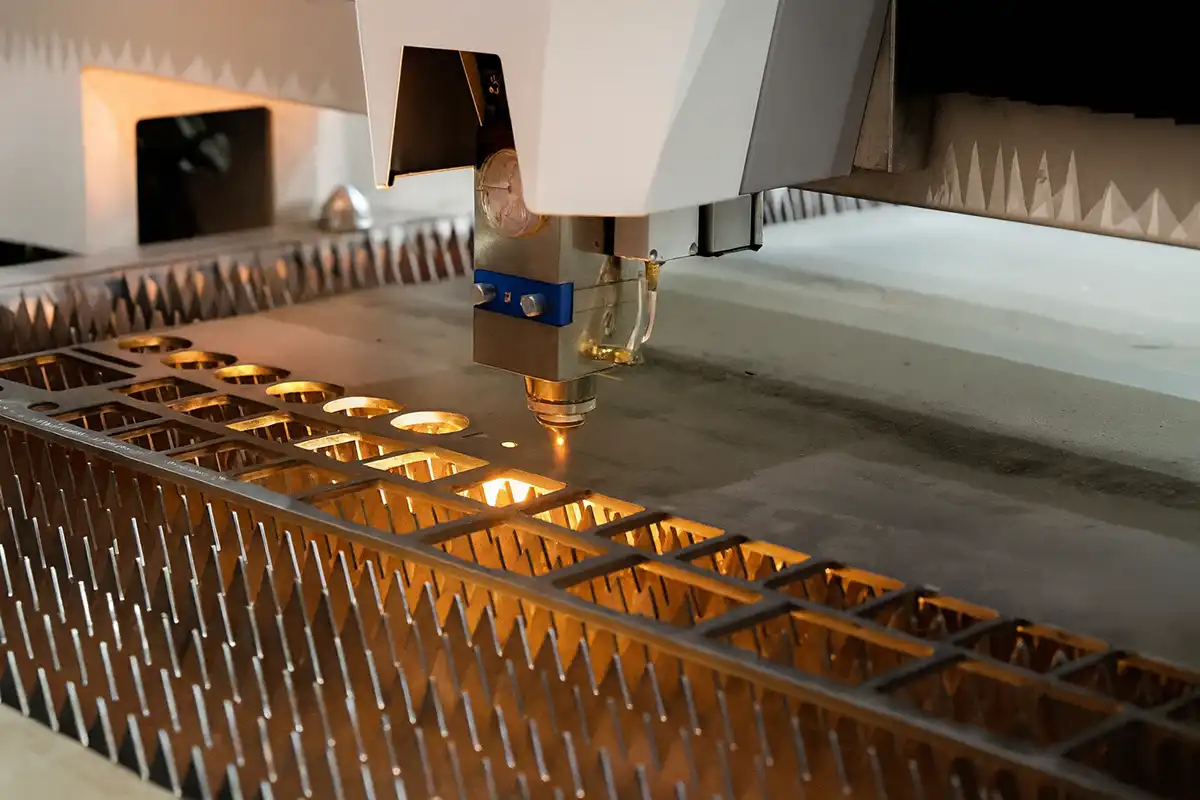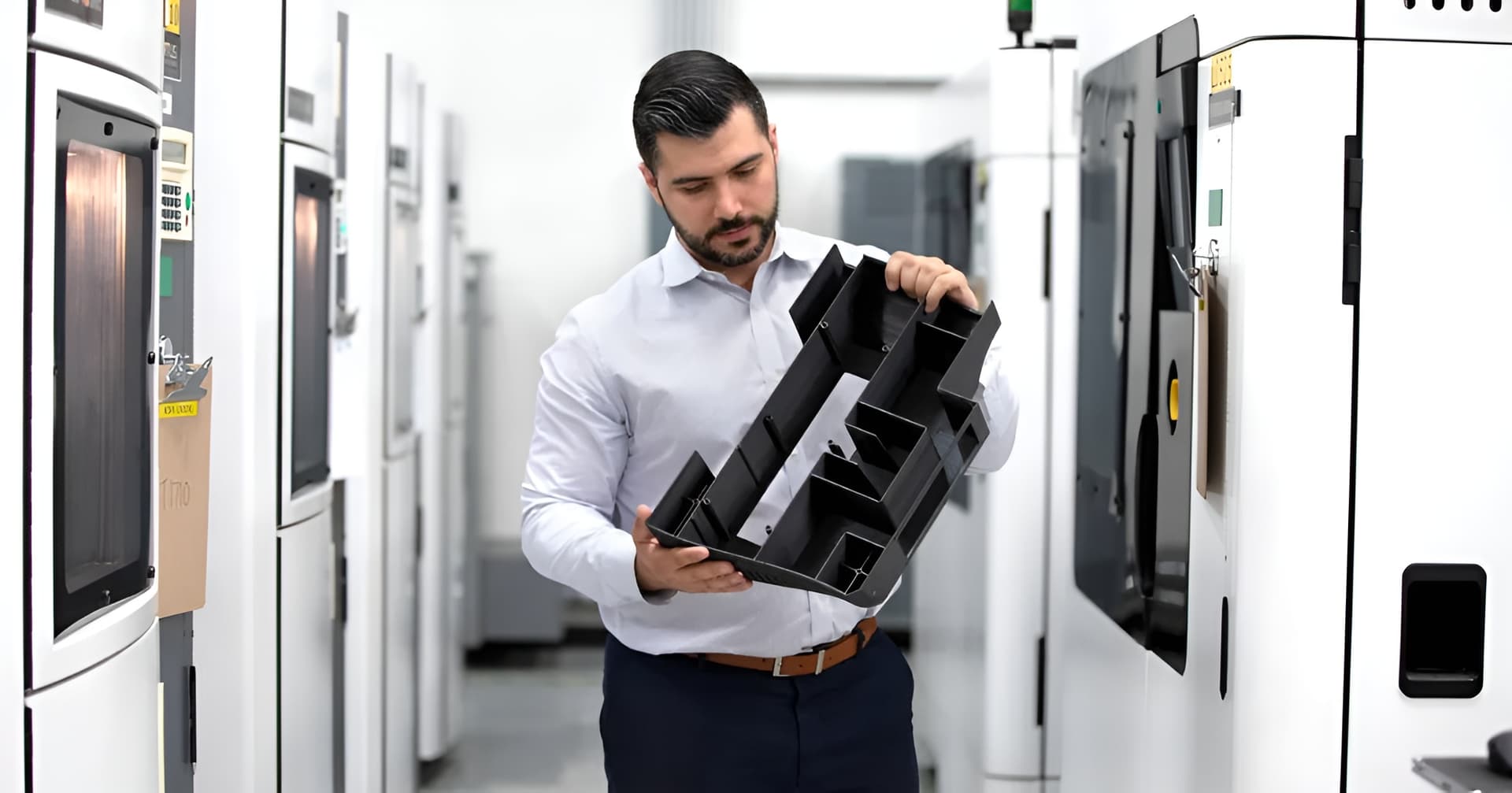Manufacturing fundamentally divides into two approaches: additive processes that build material layer by layer, and subtractive processes that remove material from stock. Understanding when to deploy 3D printing versus laser cutting determines cycle time, material efficiency, and geometric capability.
Process Fundamentals
Laser Cutting: Subtractive Manufacturing
Laser cutting uses focused energy to vaporize or melt material along programmed toolpaths. Fiber lasers dominate metal fabrication because they deliver concentrated power through solid-state optics, yielding clean edges with minimal heat-affected zones. CO₂ lasers remain common for organic materials and plastics.
The process is straightforward: flat stock is fixtured, the cutting head traverses according to 2D geometry, and finished parts drop from the sheet. Edge quality is excellent, dimensional repeatability is tight, and throughput scales with sheet size and laser power. Laser cutting excels at producing identical flat components at volume.

3D Printing: Additive Manufacturing
Additive manufacturing constructs parts by depositing material in successive layers. Powder bed fusion processes—SLS for polymers, DMLS for metals—use thermal energy to fuse powder particles. Fused deposition modeling (FDM) extrudes thermoplastic filament. Stereolithography (SLA) cures liquid resin with UV light. Each process builds complex geometry without fixturing or tool changes.
Setup time is minimal. Design files translate directly to machine instructions. Internal features, undercuts, and organic forms that challenge subtractive methods are routine in additive workflows. Parts emerge near-net shape; support removal and finishing follow based on tolerance and surface requirements.

Comparative Analysis
| Factor | 3D Printing (Additive) | Laser Cutting (Subtractive) |
|---|---|---|
| Geometry | Complex 3D forms, internal channels, lattices, organic shapes | Limited to 2D profiles; 3D assemblies require joining |
| Materials | Engineering polymers (PA12, PA11, TPU), high-temp resins, metal powders (aluminum, steel, Inconel) | Flat stock: metals, wood, acrylic, composites |
| Tolerances | ±0.1–0.3 mm polymers; ±0.05–0.2 mm metals (as-printed) | ±0.05–0.1 mm typical for laser-cut edges |
| Production Speed | Hours to days per build; scales with height and complexity | Hundreds of parts per day; limited by sheet handling |
| Material Efficiency | High; only deposits required material plus supports | Generates scrap; cut-outs may be recyclable |
| Post-Processing | Support removal, blasting, finishing, potential machining | Minimal; parts ready for assembly immediately |
| Cost Drivers | Machine time, material volume, support structure, finishing labor | Material cost, laser power consumption, sheet waste |
Material Considerations
Material pedigree influences both process choice and part performance. Laser cutting works with certified stock— aerospace alloys, structural steel, food-grade stainless—because parent material properties remain largely intact. Additive processes introduce variables: powder lot consistency, build orientation, thermal history. Qualification programs for AM materials are maturing, but laser-cut stock still dominates legacy certification pathways.
Material Performance Implications
- Isotropy: Laser-cut parts retain isotropic properties of parent stock. AM polymers exhibit directional strength dependent on layer orientation.
- Surface Finish: Laser cutting produces smooth edges suitable for sealing or aesthetic applications. Additive parts require finishing for comparable surface quality.
- Thermal Stability: Metal AM withstands high service temperatures after stress relief. Laser-cut metal meets extreme thermal and fatigue requirements immediately.
Application-Specific Selection
Deploy 3D Printing When
- Geometry includes internal channels, negative space, or organic forms
- Design iteration speed outweighs per-part cost
- Production volumes remain below 50–100 units
- Part consolidation reduces assembly complexity
- Custom or serialized components justify tooling-free production
Deploy Laser Cutting When
- Parts are flat profiles or require precision-cut sheet components
- High-volume production demands rapid throughput
- Material certification or pedigree is non-negotiable
- Edge quality and dimensional consistency are critical
- Assembly workflows rely on standardized flat components

Industry Applications
Both technologies serve aerospace, automotive, robotics, and medical manufacturing. Selection depends on component requirements. Aerospace benefits from laser-cut precision brackets and bulkheads; additive delivers lightweight internal structures and custom ducting. Robotics leverages laser cutting for chassis panels while printing complex actuator housings. Medical devices use laser-cut surgical tools and 3D-printed patient-specific implants.
Agriculture and construction favor laser cutting for structural components and mounting hardware. Education and research environments prefer additive manufacturing for rapid prototyping and iterative design validation.
Cost and Economic Considerations
Equipment costs differ significantly. Entry-level laser cutters and 3D printers range $500–5,000 for hobbyist use. Industrial fiber lasers cost $75,000–200,000; production-grade AM systems span $50,000–500,000 depending on build volume and material capability.
Operating economics favor laser cutting for high-volume flat components. Material waste increases with geometric complexity, but throughput remains high. Additive processes minimize waste and eliminate tooling but require longer cycle times. The economic crossover occurs around 50–200 units, depending on complexity and tolerance bands.
Cost Decision Framework
- Prototype and low-volume: 3D printing eliminates tooling and accelerates iteration
- Medium-volume (50–500 units): Evaluate part complexity; simple profiles favor laser cutting, complex geometry favors additive
- High-volume (>500 units): Laser cutting scales efficiently for flat parts; consider injection molding or die-casting for complex 3D forms
Emerging Trends and Technology Evolution
Additive manufacturing continues advancing through multi-material printing, AI-driven process optimization, and expanded material portfolios. Generative design tools integrate with AM to create topology-optimized structures impossible to manufacture subtractively. Metal binder jetting and continuous fiber composites extend additive into production applications previously reserved for traditional methods.
Laser cutting evolves with higher-power fiber lasers, real-time process monitoring, and robotic automation. Advanced beam control enables cutting of ceramics, technical glass, and composite laminates. Automated material handling reduces labor and increases throughput.
Both technologies trend toward sustainability: recycled feedstock, energy-efficient systems, and renewable power integration reduce environmental impact across manufacturing operations.
Decision Criteria Summary
Selecting between 3D printing and laser cutting requires evaluating geometry, material, volume, tolerance, and timeline. Neither process universally outperforms the other; each excels within specific constraints.
| Question | Impact on Process Selection | Recommendation |
|---|---|---|
| Is geometry 2D or 3D? | Flat profiles suit laser cutting; complex 3D forms require additive | Laser cutting for 2D, additive for 3D complexity |
| What production volume? | High volume favors laser cutting throughput; low volume suits additive | Additive <100 units; laser >200 units; evaluate in between |
| What tolerance is required? | Tight tolerances may require post-machining regardless of primary process | Specify critical features; plan secondary operations early |
| Is material certification required? | Laser-cut stock maintains pedigree; AM requires lot traceability | Laser cutting for certified programs; AM with documented material lots |

Forge Labs Capabilities
Forge Labs operates industrial additive manufacturing systems across polymer and metal technologies: SLS and MJF for nylon production, FDM for engineering thermoplastics, SLA for precision prototypes, and DMLS for metal components. We do not operate laser cutting in-house but collaborate with certified partners for hybrid workflows combining additive complexity with subtractive precision.
For projects requiring both processes, we coordinate design, fabrication, and finishing to deliver parts that meet tolerance, surface, and certification requirements. Upload CAD and specifications; our engineering team evaluates the optimal manufacturing pathway and provides transparent quoting and timelines.
Evaluate Your Manufacturing Path
Submit your design files and production requirements. Forge Labs engineers will assess geometry, material, and volume to recommend additive, subtractive, or hybrid manufacturing solutions with detailed cost and lead-time projections.